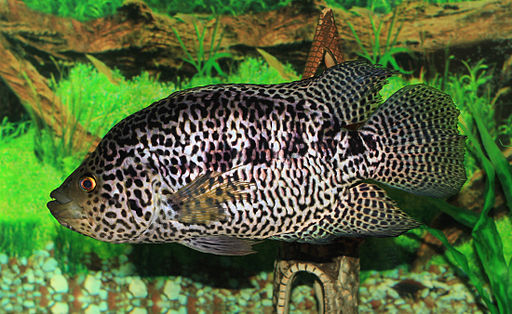Jaguar cichlid
Adult jaguar cichlid
© G. Chernilevsky, WikiCommons
© G. Chernilevsky, WikiCommons
Jaguar cichlids, or Guapote tigres, are native to Central America. In the 1960s, they became popular aquarium fish and established beyond their native habitat in neighbouring countries, then rapidly expanded to countries around the world.
Scientific name
Parachromis managuensis
Description
- Usually grow to around 20-30cm, sometimes up to 55cm.
- Weigh up to 1.6kg.
- Characterised by 'jaguar' like dark blotches on the skin, with vertical dark bars extending to the dorsal fin.
- Eye colouration is often orange or reddish.
- Single long dorsal fin characteristic to the cichlidae.
Habitat
- Warm freshwater rivers and creeks.
Distribution
- Native to Central America from Honduras to Costa Rica.
- Thought to be common in aquariums in Queensland.
- Widely distributed in streams, ponds and dams throughout the southern half of Australia.
- Established in natural waterways in Mackay, Queensland—probable aquarium dumping.
Life cycle
Breeding
- Grow quickly in aquariums.
- Little known about breeding in the wild.
- Lay 5,000-10,000 eggs on hard substrate.
- Both parents protect eggs and resulting fry.
Diet
- Highly predatory, feeds on fish and macroinvertebrates.
Impacts
- Extremely aggressive, will dominate native fish species for habitat, food and space if introduced into Australian freshwater ecosystems.
Control
If you see any jaguar cichlids in the wild, report it immediately through our online reporting form.
Take photos and keep captured specimens frozen, if possible, to help us with further identification.
Legal requirements
- Under the Biosecurity Act 2014 everyone has a general biosecurity obligation (GBO) to take reasonable and practical steps to minimise the risks associated with spreading or introducing pest fish. This includes any fish that is not native to Australia.
- To ensure you have met your GBO:
- don’t stock non-native fish in outdoor ponds
- don’t release aquarium fish or aquarium water into waterways
- do what you reasonably can to stop a potential biosecurity threat from spreading. This could include reporting the issue to Biosecurity Queensland.
